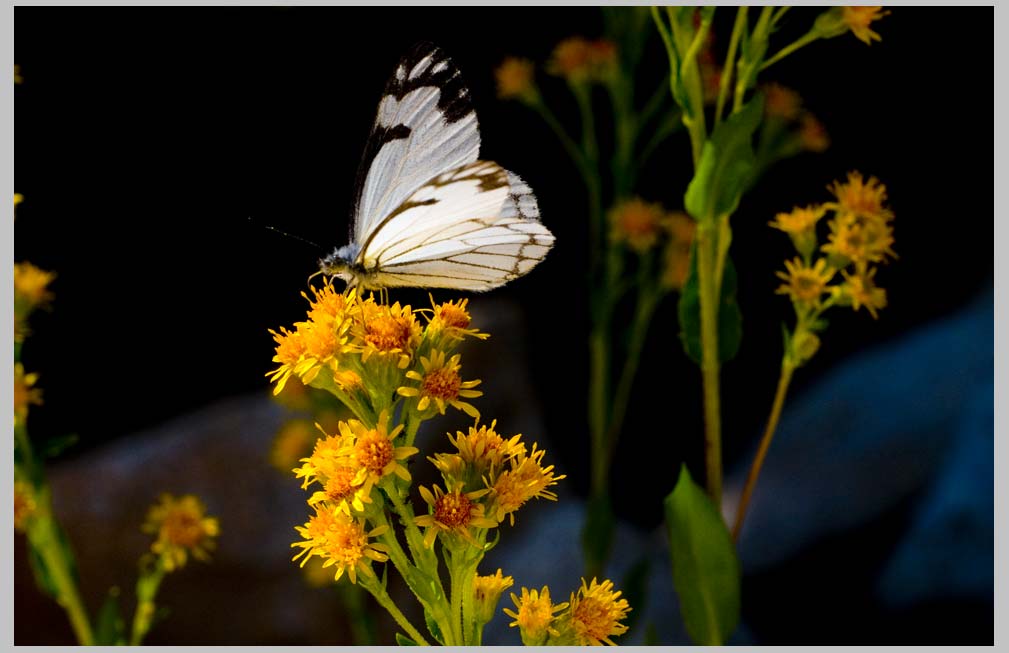

Pine White Butterfly (Neophasia menapia) on
Groundsel (Senecio integerrimus) [ click photo for next . . . ]
On the road in the American Northwest.


Pine White Butterfly (Neophasia menapia) on
Groundsel (Senecio integerrimus) [ click photo for next . . . ]
On the road in the American Northwest.
FRIEND, David Landrum, on
the Pine White Butterfly. . .
Like many hikers and climbers in the backcountry
this summer, for the second year running I have
noticed amazing slow-motion clouds of Pine White
Butterflies fluttering about. Curious to know more,
I wrote my good friend, David, a freelance field
biologist and all-round timber cruiser, to get his
view.
This is what he wrote. It's a bit technical, but
David (pictured below) really knows his stuff,
combining a sharp analytical bent with more
than 30 years of experience working in the field:
Hi Cliff,The Pine Butterfly has been quite visible this year
across the region.It was out in large numbers in Idaho and the woods
were white with them in Sumpter; before I left for
Crater Lake.At Crater Lake, I was mildly surprised to see them
on the west slope of the Cascades but in reduced
numbers during the past few days.
Furniss reports the earliest outbreak as 1882 near
Spokane, a bad outbreak in 1893-5 on the Yakima
reservation, 1922-3 outbreak in Mcall, Idaho killed 25%
of pine trees and a similar amount was killed near Boise
in 1953. A coastal outbreak occurred on Vancouver
Island in 1961. (Lots of Pinus monticola on the island).
Furniss has no reports of a regional out break.
Most of the research on Pine defoliators has focused
on the Pandora Moth; an ab solutely unbelievable
phenomena ( I have pictures).
James Speer has reconstructed 622 years of Pine
defoliation across our region using dendrochronology;
and while it is possible to distinguish between Pine
Butterfly Events and Pandora events in the tree rings;
it is also possible to make mistakes as he relies in
part on geographical separation.
Be careful when interpreting diet in Butterflies.
To a certain extent in most adults (butterflies) diet is
insignificant outside of the pollination services the
butterfly provides in exchange for nectar.
Adults are an ephemeral resource and food or nectar
is only meant to maintain the adult, long enough to
breed and disperse; into future suitable habitat; and
sometimes food is not even necessary for that.
Food for the larva (caterpillar) is very important.
Caterpillars are somewhat degenerate. In insects this
means limited mobility such that the larva must
maintain some sort of living relationship with an
immediate food source. In the Pine butterfly (larva)
this is pine needles. It is also difficult to interpret
balance, as insects often have fluctuating populations
that are asynchronous with environmental cues.
There are always local, areal and regional imbalances
that we recognize as endemic, epidemic and
pandemic population out breaks.
Currently we seem to have a regional scale event.
I do not know if it is pandemic but an event of
synchronous timing as opposed to asynchronous
suggests it might be. These events tend to run for
several years. Since caterpillars tend to aggregate in
huge numbers and are gregarious, there is a natural
virus (NPV) that usually gets into defoliator colonies
and knocks back the populations and can even
extirpate butterflies from large areas. These self-regulating
events seem to occur at the same time our chemical
engineers decide to fight these so called "pests" with
aerial warfare or sprays. These chemical war events
wreck havoc on non-target species, including birds.
As to climate change or environmental stress. Stress
of many types including general poor health of crowded
and weakened trees as well as weather conditions
all favor insect disturbance events. With the Pine
Butterfly though we are faced with a confusing position.
Pine butterflies are thought to be a limiting factor at
the upper elevations of Ponderosa Pine growth in that
the greatest disturbance in Pines is thought to be at
higher elevations and that the butterfly does not cause
as much damage at the lower elevations of pine growth.
It could be argued that this is one factor in differentiating
the transition our pine forests from our fir forests in
addition to climate. Available moisture is also
important in insect nutrition and this maybe important
in the distribution of our Pine butterfly such that lower
elevations have less available moisture and less
butterflies. There is a great book, called Insect
Nutritional Ecology, that speaks to the specifics
of the need for the right balance of both food
and moisture as limiting factors in insects.
In general we think of global warming as the process
where a pest such as the mountain pine beetle goes
up in elevation to attack whitebark pine trees; where
as whitebark pine used to be protected by growing
in a climate zone that is to cold for beetle outbreaks.
Could a pest also move into warmer zones?
Several sources reference this, including California
Pests of Native Conifers and Speers work on Pandora
moths. Of course, our natural systems are complex,
and both adult and larval insects maybe responding
to global warming and their attendant host plants
in different ways; and of course moisture
Done at Crater Lake and headed to BakerDavid [IX.8.2011]
Featured gallery, 100 MINIATURES, a set of 100 black & white photographs. ONE image. ONE idea. ONE new way of looking . . .100 MINIATURES—online gallery
Each miniature is a kind of meditation on one idea & one image;
Each lasts 30 seconds; They play in random order;
The music is my BOREA Mix,
for hand-played ePecussion Orchestra.
[ mouse over for controls / lower right fro full-screen ]
All Photographs & texts by Cliff Crego © 1998-2015 picture-poems.com
(created: IX.15.2011)